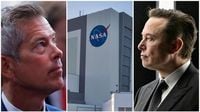There’s a new front in the battle for America’s future in space, and it’s playing out not in the vacuum of lunar orbit but in the public eye—on social media, in the halls of government, and across the country’s most powerful agencies. At the center of this storm are two outsized personalities: billionaire entrepreneur Elon Musk and U.S. Transportation Secretary Sean Duffy, who also currently serves as Acting Administrator of NASA. Their escalating feud has exposed deep rifts in how the U.S. should pursue its next giant leap, with implications for the direction, priorities, and even the very structure of the nation’s space program.
The most recent—and most public—salvo came on October 21, 2025, when Musk responded to Duffy’s criticism of SpaceX’s progress on the Artemis III moon mission with a viral and widely condemned homophobic GIF on X, his own social media platform. The post, which many saw as both offensive and a dodge of the real policy issues, was just the latest in a series of increasingly personal attacks. Musk followed up by calling Duffy “Sean Dummy” and accusing him of “trying to kill NASA.” According to the International Business Times, Musk further charged that Duffy’s rumored plan to fold NASA into the Department of Transportation would “end America’s leadership in space,” adding, “the person responsible for America’s space programme can’t have a two-digit IQ.”
Duffy, for his part, has largely avoided responding in kind. Instead, he told CNBC, “I want to get to the moon in this president’s term, so I’m going to open up the contract. I’m going to let other space companies compete with SpaceX, like Blue Origin.” He added, “Great companies shouldn’t be afraid of a challenge. When our innovators compete with each other, America wins!” as reported by NOTUS. The message was clear: the government would not wait for one company, no matter how storied, to deliver on the Artemis III promise of returning American astronauts to the moon for the first time in over fifty years.
What’s driving this public spat? It’s more than just bruised egos. According to India Today, the feud is a proxy for a fundamental policy battle over the future structure of NASA and the American space program. Duffy’s dual role as Transportation Secretary and Acting NASA Administrator has placed him at the center of a push to integrate key NASA functions into the U.S. Department of Transportation (DOT). The rationale, supporters say, is rooted in the technical and logistical challenges posed by a commercial launch boom that’s straining the national airspace system.
Executive Order 14335, titled “Enabling Competition in the Commercial Space Industry,” mandates that the DOT Secretary “eliminate or expedite” licensing and environmental reviews for commercial launches, with the goal of “substantially increasing commercial space launch cadence... by 2030.” The FAA, which manages the National Airspace System under DOT, has reportedly struggled to keep up with the increasing frequency of launches and reentries. Placing NASA under the DOT, advocates argue, would ensure that the agency responsible for launch safety and logistics also has institutional control over exploration missions, forcing NASA to adhere to transportation schedules and regulations.
But critics warn this realignment comes at a high cost. Budget documents reviewed by India Today confirm that funds for civilian space programs are being refocused solely on the lunar race, with the aim of ensuring the U.S. beats China back to the moon—potentially as soon as 2028. The administration’s budget strategy, some say, is circumventing Congress by using Office of Management and Budget guidance to halt dozens of scientific programs. The result? Up to 5,000 NASA positions could be eliminated, and 41 missions—including the Chandra X-ray Observatory—may be canceled. Analysts caution that sacrificing foundational science for a short-term geopolitical win could erode the technological ecosystem necessary for long-term leadership and innovation in space.
This tension—between logistical efficiency and scientific exploration, between commercial competition and national prestige—has been exacerbated by the personalities involved. Duffy, a 54-year-old former Republican congressman and competitive lumberjack, has made no secret of his ambition to remain at the helm of NASA and oversee its absorption into the DOT. According to NOTUS and the Wall Street Journal, he’s been lobbying within the Trump administration to secure his position, even as White House insiders grumble that he’s “caused chaos” and “spent the last couple of weeks being a cowboy.” One administration official told NOTUS, “There are people in the White House who believe Duffy has made unnecessary chaos rather than just accept that his time is in the sunset.”
Musk, meanwhile, has used his platform and considerable influence to champion his own vision for NASA—and, some say, his own allies. Earlier in 2025, President Donald Trump withdrew the nomination of Jared Isaacman, a billionaire commercial astronaut and Musk confidant, to head NASA. Isaacman later said his name was pulled because “some people had axes to grind.” Since then, Musk has publicly supported Isaacman and reposted messages calling for his reinstatement. The two camps—Duffy’s and Isaacman’s—have reportedly been lobbying the administration, even reaching out to President Trump directly.
The stakes are high. SpaceX currently holds a £2.3 billion ($2.9 billion) contract to develop the lunar lander for Artemis III, with a potential launch by 2028. Duffy has repeatedly warned about China’s rapid progress in space, noting the country’s plans to send astronauts to the moon by 2030. NASA Press Secretary Bethany Stevens told The Independent that Duffy’s top priority is ensuring “America gets back to the moon before China,” and that he’s committed to maintaining U.S. leadership in space.
Yet, the methods and rhetoric have left many uneasy. Musk’s social media attacks—particularly the use of a homophobic meme—have drawn widespread condemnation from political figures and the public alike. Critics argue that such posts distract from serious policy debates and risk undermining public trust in the institutions responsible for America’s space future. Meanwhile, Duffy’s aggressive push to realign NASA under DOT has alarmed scientists and agency staff, who fear the loss of core research missions and the transformation of NASA from a pioneering explorer into a mere customer agency focused on logistics.
As the feud continues, the White House has sought to project unity—at least outwardly. Spokesperson Liz Huston told NOTUS that Duffy is a “trusted, valued, and loyal member of the president’s team,” but added, “As for the NASA Administrator nomination, it’s solely up to President Trump to make a decision and it will be announced by him directly when it’s made.” For now, the administration appears content to let the rivalry play out, even as the future of American space policy hangs in the balance.
With the race to the moon heating up and the fate of NASA’s scientific legacy in question, the next steps by Musk, Duffy, and the White House will shape not just the Artemis program, but the very identity of America’s space ambitions for decades to come.




